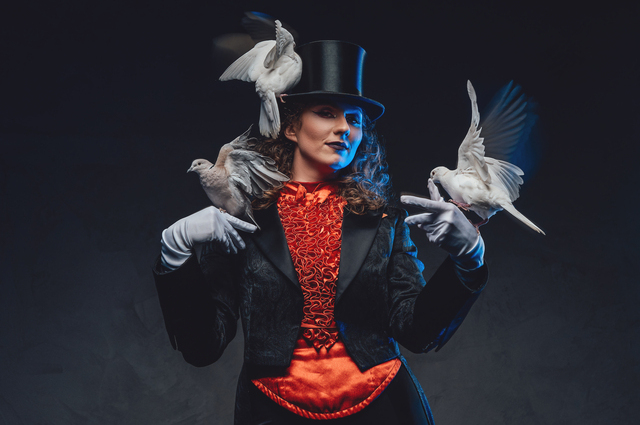Vegas Magic Shows

These days, the internet provides a virtually infinite amount of information on any field. It is available to all of us, anytime. In that context, how are we still amazed by magicians performing a trick at a show? Read on to find out about magic in our lives and, of course, in Vegas!
Do We Still Love Magic?
Short answer: yes. It’s important to remember that, like anything, magic exists within a context. Any form of art is inextricably linked to the time period it takes place. If we watch footage of a magic show from the late 1800s, we will automatically think: “Oh, that looks horrible!”. However, considering the general knowledge of science at the time, what looks childish to us was a great mystery for those audiences.
Magicians are always looking for new tricks. They will use the currently available technology to play on the latest hopes, fears, and knowledge of the audience. Audiences in the early days of magic shows were amazed by simple moving projections on a background. Nowadays, we are blown away by the special effects in an IMAX theater. In both cases, on those stages was/is brand new technology.
Fear or Entertainment? The Early Years of Magic Shows
Magic performances started in Paris at the end of the 18th century. They used to be a kind of frightening entertainment using the then modern magic lantern. Étienne-Gaspard Robert was famous for his so called phantasmagoria spectacles.
These shows took place at night, at a graveyard. After walking through the gravesites, the already disorientated audience was led into a spooky, chilly auditorium. Suddenly, a seemingly magical appliance would make images appear and disappear. Within those very gloomy surroundings, these images were obviously regarded as ghosts.
In reality, the show was designed around optical effects to create these illusions for the audience. The basic plot for these early performances was the same as for any magician: appearing and disappearing. What really changed over time? The resources available for performers in order to amaze their audiences.
Scientific Illusions
The early 19th century saw a great deal of scientific progress driven by the Industrial Revolution. A new magician, Robert Houdin, appeared in this context. Like other magicians of his time, Houdin was very interested in science. He is considered the father of modern magic due to the scientific nature of his work. Before him, magicians were regarded as charlatans of the dark ages of superstition.
Robert Houdin worked as a clockmaker. Along with that, he had great skill as a performer on stage. His real innovation was taking clockwork mechanicals and using them to create magic. One of his most famous illusions involved a mechanically automated orange tree, which relied on the same plot of appearing and disappearing.
Science and Magic in a Larger Scale
In mid-1800s London, there was a theater entirely dedicated to magic. The Egyptian Hall, also known as “England’s Home of Mystery”, held performances where Magicians often bamboozled the audience with supposed scientific explanation.
The Egyptian Hall marked its era because of the possibilities it allowed. Performers could furnish the theater with all kinds of equipment because it would be used exclusively for magic performances. Some historians regard it as being the home for Vegas-style extravagant entertainment—just like this website with discount tickets for magic shows.
Back in the 19th century and nowadays, magicians sometimes show a scientific principle and give the idea that they are going to use it, while the actual trick is much simpler. It’s all about the effect on the audience.
What Do You See?
Psychologist Richard Wiseman helps us understand the fascination behind magic performances. He says that we think we are sophisticated observers, when in fact we are not. We make assumptions about reality and all magicians do is play with those suppositions to fool us.
So, the question is: do we see what is there, or do we see what we want to see? There is no right answer, and magicians will play with the possibilities. And we will pay them for it. At the David Copperfield Theater in Las Vegas, you have the opportunity to witness the so-called “greatest illusionist of our time”. He will be fooling you into things you know are not real, but which will still make your heart race faster.
Finding Magic Around Us
Whimsical Moments
Famous illusionist Franz Harary says “Magicians lie to you, and are honest about it. The audience goes into the theater with the understanding that they are going to be fooled.”. Harary has already performed acts like disappearing London’s Tower Bridge. Of course, spectators knew the bridge was still there in reality. But they were struck anyway. Why? “What you see becomes your reality”, says Harary. Magic occurs in the minds and the expressions of the people watching it.
Therefore we may ask ourselves: what is magic? When we are children, we are amazed by any new thing that we learn. With time, we tend to lose this element of excitement. Some people want back that feeling that we all had as a kid. It may be brought back by elaborate magic performances, or by smaller events in our lives. How could a car ride, for example, be made magical and unforgettable?
Being Chauffeured to Joy
The majority of us ride cars on a daily basis. It’s most likely your means of transportation to work and to leisure. We probably don’t remember each of our rides from this week, for example. This may change when you choose chauffeured transportation.
Luxury ground transportation is more than a ride, it’s an experience to remember. Every detail of the ride will be taken care of by a team that includes your private chauffeur. Find out more about exquisite customer service and make your next ride remarkable with Vegas VIP Limousine.
